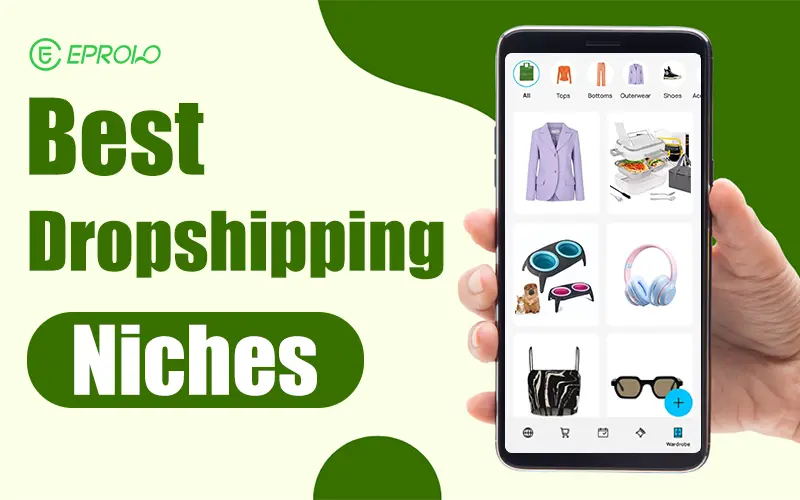In 2025, eCommerce is booming, making it the best time to get started. Dropshipping has limitless potential, but sustainable success depends entirely on your chosen niche.
Picking the right niche is challenging. A common mistake is choosing a category that is too broad, like “clothing,” which creates massive competition. Should you focus on your personal interests or on proven profitability? This article presents 15 of the best dropshipping niches, moving beyond broad categories to provide a strategic analysis of high-potential sub-niches that match today’s consumer preferences.
Whether you’re new to dropshipping or refining your strategy, these niche ideas will guide you toward building a profitable online store. With the right approach, you can tap into the growing eCommerce market and create a successful business.

Page overview:
How to Find a Profitable Dropshipping Niche
15 Best Dropshipping Niches in 2025
5 Niches to Stay Away From in Drop Shipping
How to Evaluate Competition in Your Chosen Niche
What Is a Dropshipping Niche
A dropshipping niche is a specific, focused subcategory within a larger market, designed to meet the needs of a particular group of people. Instead of selling a broad range of products (like general “electronics”), a niche-focused dropshipper selects a specific category, such as “PC gaming peripherals” or “home surveillance cameras.”
Dropshipping is a business model that allows sellers to operate without handling storage or transportation. When the store makes a sale, it purchases the product from a dropshipping supplier, who then ships it directly to the customer. Choosing a niche means targeting a specific customer profile and focusing on differentiating your store from competitors.
A well-defined niche is effective for several reasons: it reduces direct competition, makes marketing efforts more effective (and cheaper), and helps build a loyal customer base. Focusing on a target group allows for a tailored marketing strategy, better market visibility, and stronger customer loyalty. Choosing the best niche for dropshipping is a critical factor in your store’s profitability and long-term sustainability.
How to Find a Profitable Dropshipping Niche
To find a profitable dropshipping niche, you must conduct thorough market research and understand specific customer needs. Here’s how to identify trends and evaluate the potential of dropshipping niches:
1. Utilize Market Research Tools
Market research tools are essential for revealing trends and identifying profitable niches with strong growth prospects. Below are some popular tools to consider:
Audience Insight
Understanding your audience is crucial. Meta’s Audience Insight provides information about Meta users, such as demographic data, preferences, and shopping behavior. By using this tool, you can gauge the market size for your niche, identify customer locations, and see their other interests.
Google Keyword Planner
Google Keyword Planner is perfect for understanding keyword demand and competition. Use specific, long-tail search queries like “sustainable fashion” or “home gym equipment” to understand consumer interests and search trends, rather than broad, competitive terms.
Google Trends
Google Trends allows you to explore the popularity of a keyword or topic over time. It helps identify growing, stable trends and allows you to avoid temporary fads that may die out quickly.
Online Marketplaces
Analyze marketplaces like Amazon, eBay, and Etsy to see real-world product trends and customer reviews. Check their best-selling products and, more importantly, read the 1-star and 3-star ratings. Buyer feedback often reveals pain points and identifies potential product opportunities or gaps in the market.

2. Consider Passion-Driven Markets
Passion-driven markets are excellent niches. They are based on customers’ hobbies or deep interests, which often contribute to higher engagement, strong community building, and better customer loyalty. People tend to spend discretionary income on things they are passionate about, making a hobbyist market a viable option.
For instance, consumers in industries such as fitness, DIY crafts, or pet care are always seeking new products to enhance their experiences. By targeting these markets, you engage with customers who are already primed to buy, leading to higher conversion rates.
It is also easier to build a brand and create effective storytelling strategies when focusing on passion niches. Social media platforms like Instagram and TikTok are highly effective for creating communities around these interests.
When selecting a passion niche, ensure the market has enough product diversity. For example, a gaming niche can include accessories, merchandise, and themed decor. Also, look for recurring purchases by targeting niches with consumables or upgrades (e.g., fitness supplements, crafting materials).
3. Focus on Accessory-Heavy Niches
Accessory-based niches are highly strategic for dropshipping, as they involve complementary products customers need alongside a primary, more expensive item (which you don’t have to sell). These niches are built on improving or personalizing something people already own and love, making them highly profitable and perfect for cross-selling.
High-demand accessory niches include smartphone accessories, car accessories, and pet supplies. Products in these niches are often small, light, and easy to source, which is ideal for a dropshipping model. These products often need replacements or updates (like phone cases) or are bought in multiples, ensuring repeat purchases.
These niches are also easier to scale. If you start by selling car air fresheners, you can expand into related categories like travel accessories or maintenance tools.
4. Identify Trends and Products Not Easily Found Locally
To succeed in dropshipping, focus on trending products that are scarce or not easily available in local brick-and-mortar stores. This “scarcity” or “convenience” factor gives your online store a distinct edge.
Trends often emerge online before they hit physical retail. Using tools like Google Trends, Pinterest, and TikTok helps identify these trends early. Watch for rising interest in specialized eco-friendly products, unique tech gadgets, or specific aesthetic-driven items.
Customers are attracted by exclusivity and novelty. Think of products like foldable travel mugs, minimalist desk organizers, or specialty skincare tools. By meeting needs that are not being met by local stores, your dropshipping business can capture a dedicated audience.
5. Test Your Niche
Before fully committing inventory and a large budget to a dropshipping niche, you must validate its potential. Testing ensures the niche has genuine demand and helps you avoid costly mistakes.
Start by creating a simple, single-product online store or a landing page to showcase your core products. Use small, targeted paid ad campaigns on TikTok or Google to drive initial traffic. Track key metrics: click-through rates (CTR), cost per click (CPC), and especially conversion rates. This data is more valuable than friends’ or family’s opinions.
Social media is another powerful tool for testing. Create engaging content around your niche to measure audience response and interest. This testing phase provides invaluable insights to refine your product offerings and marketing strategy, building a strong foundation for long-term success.

15 Best Dropshipping Niches in 2025
Discovering the right dropshipping niche defines your success in 2025. The following niches are sub-categories shaped by evolving consumer preferences and data-backed market trends, holding immense potential for growth and profitability.
1. Car Organization & Upgrades
Car accessories are increasingly popular as people seek to enhance their vehicles. Modern drivers want products that improve comfort, safety, and aesthetics. This demand for convenience drives sales.
The market is growing due to rising car ownership and customization trends. The global automotive ecommerce market size is projected to reach USD 343.13 billion by 2032, exhibiting a CAGR of 16.6% during the forecast period.
Top dropshipping products to focus on:
- Car organizers (trunk, backseat)
- Specialty phone mounts
- Dashboard cameras
- Car air purifiers
- Tire pressure monitors
- LED interior lights
- Portable jump starters
2. Sustainable Home Goods
Green consumerism is a powerful, long-term trend. Consumers are actively seeking environmentally friendly products to reduce their carbon footprint. With rising sustainability awareness, products like reusable bags and biodegradable items are in high demand.
Search interest for sustainable products has grown steadily, with a 71% increase recorded globally. Furthermore, 72% of consumers report purchasing more eco-friendly products than they did five years ago.
Essential products for this market:
- Reusable water bottles
- Bamboo utensils & cutting boards
- Beeswax wraps (food storage)
- Biodegradable phone cases
- Solar-powered chargers
- Eco-friendly cleaning supplies
- Compost bins
- Reusable makeup pads
- Tote bags
3. Home Fitness & Yoga Gear
Fitness products remain a top-tier niche, especially with the rise of home workouts. The global fitness industry is expected to grow by 8.59% (2022-2029) to a market volume of US$9.37bn in 2029.
The industry is growing due to increasing health awareness. Home fitness products are popular as people seek convenience. Therefore, the demand for portable, space-saving items like resistance bands, smart watches, and yoga mats is consistent.
Recommended items for this niche:
- Resistance bands (sets)
- Yoga mats (eco-friendly, extra-thick)
- Adjustable dumbbells
- Kettlebells
- Fitness trackers
- Foam rollers
- Pull-up bars
- Jump ropes
- Workout apparel (leggings, tops)
- Hydration packs

4. Niche Beauty & Skincare Tools
Cosmetics and beauty are one of the best niches, driven by the rising trend of self-care. The global cosmetics market was forecast to generate revenues of nearly 132 billion U.S. dollars by 2029.
The opportunity here is not in general makeup, but in niche segments: environmentally friendly, cruelty-free, and diverse products. Skincare gadgets and vegan cosmetics are in high demand.
Top choices for this niche:
- Specialty face masks (e.g., LED, clay)
- Targeted serums (e.g., Vitamin C, Niacinamide)
- Vegan lipsticks
- Jade rollers & Gua Sha tools
- Makeup brush sets (and cleaners)
- Reusable makeup remover pads
- Organic shampoos
- At-home nail kits
- False eyelashes (magnetic)
- Beard grooming kits
5. Smart & Specialty Pet Supplies
Pet adoption rates continue to rise, especially among millennials. This has fueled a massive upward trend for pet supplies. Owners seek to pamper their pets, driving demand for grooming tools, tech, and personalized accessories.
The pet care market is expected to grow to USD 427.75 billion by 2032. Pet owners look for products that enhance comfort, health, and style.
Consider these items:
- Pet beds (orthopedic, calming)
- Interactive toys (puzzle feeders)
- Grooming kits (clippers, brushes)
- Pet cameras (with treat dispensers)
- Travel carriers
- Automatic feeders
- Pet harnesses & LED collars
- Cat scratching posts
- Pet water fountains
6. Modern Baby Essentials & Safety Gear
The baby products niche sees consistent demand as new parents seek quality, safety, and convenience. Parents are increasingly searching for high-quality, eco-friendly options. This has fueled demand for organic baby clothing, eco-friendly diapers, and smart baby monitors.
The global baby products market size is expected to grow at a CAGR of 5.9% from 2024 to 2030.
Consider the following products:
- Baby monitors (smart, video)
- Diaper bags (backpack style)
- Swaddle blankets
- Teething toys (silicone, non-toxic)
- Bottle warmers
- Baby carriers & slings
- Play mats
- Baby-proofing kits
- Silicone bibs
7. Comfort & Wellness Bedding
People are spending more time at home and investing in their personal comfort, making bedding and home products a strong niche. Products like memory foam pillows and weighted blankets have become mainstream.
The demand for comfortable, aesthetically pleasing, and functional home products is rising. As a result, the global market for home goods will be worth $1097.51 billion by 2032.
Consider these products:
- Memory foam pillows
- Weighted blankets
- Silk or satin pillowcases
- Mattress toppers
- Blackout curtains
- Throw blankets
- Cooling sheets
- Aromatherapy diffusers

8. Mobile Productivity & Power Accessories
Our reliance on smartphones has driven massive demand for phone accessories. The global mobile phone accessories market size is expected to reach US$151.97 billion by 2028.
As new phone models are released, the market for accessories is constantly refreshed. Users look for accessories that improve utility, safety, and personalization.
Must-have products for this store:
- Wireless chargers (3-in-1 stations)
- Phone cases (protective, aesthetic, biodegradable)
- PopSockets / Phone grips
- Magnetic car mounts
- Camera lens protectors
- Screen protectors (tempered glass)
- Portable power banks
- Charging cables (braided, long)
- Earbuds
- Selfie sticks / tripods
9. PC & Console Gaming Peripherals
Gaming is one of the world’s most popular forms of entertainment. With the industry’s rapid growth, there is a high, passion-driven demand for gaming accessories that enhance the experience.
Gamers want innovative gadgets to improve performance and aesthetics. They look for quality, durability, and customization (e.g., RGB lighting).
Focus on stocking these key items:
- Gaming headsets
- Mechanical keyboards
- Gaming mice
- Large mouse pads (desk mats)
- Gaming chairs
- Controllers (and custom grips)
- VR headset accessories
- Console stands (with cooling)
- LED light strips
- Joystick grips
10. Personalized & Niche Jewelry
Jewelry is an enduring and highly profitable dropshipping niche, especially when focused on personalization. The market for jewelry is expected to expand to US$0.45 trillion by 2029.
It remains popular as a means of self-expression. Consumers today want unique pieces. Jewelry also commemorates significant life events, creating high-intent purchases.
Products to include in your offerings:
- Personalized necklaces (engraved, nameplates)
- Rings (stackable)
- Bracelets (charm, custom)
- Earrings (hoops, studs)
- Watches
- Anklets
- Gemstone pendants
11. Kitchen Gadgets & Small Appliances
A growing trend of home cooking and entertaining has sparked increased interest in kitchen and dining products. As people focus on creating more comfortable and stylish home environments, the demand for quality kitchen essentials continues to grow.
Consumers seek innovative products that enhance convenience, style, and functionality.
Consider adding these items:
- Blenders (portable, personal-size)
- Air fryers
- Knife sets
- Wine racks
- Specialty cutting boards
- Spice racks
- Silicone baking mats
- Coffee makers (pour-over, french press)
- Dinnerware sets
- Electric can openers

12. DIY & Crafting Kits
In line with the rise of the DIY movement, art and craft activities have gained popularity. Many people embrace crafting to relax, express themselves, and even generate income. This niche thrives on a passion for DIY.
Products to consider (focus on kits):
- Paint-by-number sets
- Knitting & crochet supplies
- Sketchbooks & art pens
- Embroidery kits
- Scrapbooking materials
- Clay sculpting tool kits
- Beads for jewelry making
- Craft scissors
- Sewing kits
13. Home Office Ergonomics & Organization
The rise of remote work has created a permanent need for office products that create comfortable, productive work environments. Consumers are actively seeking items to enhance their workstation quality. The office supplies market is projected to reach USD$198.9 bn by 2032.
Here are product ideas to explore:
- Desk organizers
- Ergonomic chairs
- Laptop stands
- Blue light glasses
- Notebooks & planners
- Whiteboards (desk size)
- Ergonomic mouse pads
- Cable organizers
- Office planners
14. Portable Outdoor & Camping Gear
People are increasingly seeking outdoor experiences. Weekend getaways, hiking, and water sports continue to grow in popularity and have increased demand for outdoor exploration gear.
This is a great niche as the popularity of adventuring increases demand for quality camping gear. The global outdoor gear equipment market size was USD 55.12 billion in 2023, and the market is projected to reach USD 94.3 billion by 2032.
Top choices for your inventory:
- Tent sets (2-4 person)
- Sleeping bags
- Portable grills
- Hiking backpacks
- Camp stoves
- Hammocks
- Solar-powered lanterns
- Cooler bags
- Waterproof clothing
- Trekking poles
15. CBD Wellness Products
CBD has become a booming niche due to its perceived benefits, such as stress relief and pain management. With growing demand for natural wellness products, CBD is increasingly popular. The CBD products market is expected to grow to US$6.91bn by 2025.
Popular dropshipping items in this niche:
- CBD oils
- Gummies
- Tinctures
- Topicals (creams, balms)
- Capsules
- CBD skin care
- Bath bombs
- CBD for pets
- Sleep aids

5 Niches to Stay Away From in Drop Shipping
While dropshipping can be profitable, our experience shows some niches are inherently problematic for beginners due to high costs, high return rates, or legal complexity. It is crucial to identify these challenges.
1. Clothing
One of the most difficult niches is clothing, as it’s hyper-competitive. The primary problems encountered in the clothing niche are issues with sizing and, consequently, extremely high rates of returns. Customers often return items due to incorrect sizing or poor fit, leading to increased costs and customer dissatisfaction.
If you must enter this niche, avoid general apparel. Instead, partner with clothing suppliers that offer reliable sizing charts and clear return policies. Consider niching down to items with “one size fits all” or simple sizing (S/M/L) like t-shirts or accessories.
2. Furniture
Bulky furniture comes with prohibitive shipping costs that can destroy your profit margins. There is also a very high risk of damage during transit in this niche.
If you decide to join this market, you must choose furniture dropshipping suppliers with local warehouses (e.g., in the US or Europe) to reduce shipping times and costs. EPROLO’s US warehouses offer fast shipping for furniture dropshipping. You must have strong packaging and provide customers with accurate delivery times.
3. Watches
Watches can be high-margin products, but the niche is saturated with competition, from low-end knock-offs to high-end luxury brands. A lack of expertise can cause you to source imitation or defective watches, leading to high return rates and customer complaints.
To succeed in dropshipping watches, you must educate yourself to avoid imitations. Partner with reputable suppliers and offer warranty protection to build trust. Consider focusing on a very specific style, like minimalist wooden watches or smartwatches.
4. Health and Wellness Products
This niche (especially supplements or consumables) is governed by strict compliance rules. It poses challenges in terms of product safety, certifications, and legal requirements (e.g., FDA in the US). It also carries a high risk of product effectiveness claims, which can lead to customer disappointment and legal issues.
Only partner with suppliers who can provide products that are certified, tested, and compliant with the regulations in your target country. Building trust by providing lab results and offering a money-back guarantee is essential.
5. Seasonal Products
The demand for seasonal products, for example, Christmas gifts or summer pool floats, is not constant. This presents a major problem in marketing consistency and cash flow.
It is advisable to expand your product range to include items that maintain demand throughout the year. If you focus on seasonal items, your marketing strategy must be planned months in advance to create buzz before the peak season, and you must have a clearance strategy to empty your inventory after the peak.

How to Evaluate Competition in Your Chosen Niche
Evaluating your competition is critical. This analysis helps you identify unique ways to position your brand and find gaps in the market. The following are practical strategies to evaluate the competition in your chosen niche.
Use Google Search to Discover Competitors
Performing a keyword search on Google is the simplest method to identify your competitors. Enter your niche keywords (e.g., ‘ergonomic desk organizers’ or ‘eco-friendly yoga mats’) and scan the top 10 results. These are your major competitors and show you the SEO challenges you’ll face.
Look at their website layout, the products they offer, and the type of content they use (blogs, guides). Are they using an SEO strategy, or is their website filled with ads? Analyzing their search engine rankings shows the level of market competition.
Use SEO Tools to Assess Keywords
To truly understand the competition, use SEO tools like Google Keyword Planner or SEMrush. These tools provide insights on search volume, keyword difficulty (competition), and relevant adjacent keywords.
If a keyword has a high search volume and high competition, it will be very difficult and expensive to rank for. Look for long-tail keywords (more specific phrases like “portable blender for travel”) which help target niche groups with less competition.
Analyze Your Competitor’s Website
After identifying competitors, analyze their websites. Evaluate their website design, user experience, product range, and pricing strategies.
Is the website easy to navigate? Are products described in detail with high-quality images? Do they have customer reviews? Observe how they convey their value proposition—do they compete on price, or do they emphasize quality and premium products? This analysis will reveal gaps you can fill.
Also, check their customer service features, such as live chat, support hours, and, most importantly, their return policy. This helps determine the level of customer service required to stay competitive.
Evaluate Their Social Media Presence
A business’s social media presence reveals its brand-building efforts. See how often your competitors are active on social media platforms such as Instagram, Facebook, or Pinterest. How do they interact with their followers?
What kind of content are they sharing: product shots, customer testimonials, or how-to guides? Are they using user-generated content (UGC) or collaborating with influencers? The level of engagement (likes, comments, shares) is a strong indicator of brand loyalty. If competitors are very active, it means you will also need a strong content strategy to stand out.
Check Marketplaces to See What’s Selling Well
Marketplaces like Amazon, eBay, and Etsy are gold mines for competition analysis. They reveal real-time information on which products are popular.
Search for your niche products and analyze the best-sellers. Read the customer reviews—especially the negative ones. Are there common complaints or areas where competitors fall short (e.g., “product broke,” “smaller than expected”)? This could be an opportunity for you to source a better product or write a more accurate description.

Conclusion
Selecting the best niche is the most critical first step for starting a successful dropshipping business in 2025. Success is not random; it comes from analyzing data-backed trends, understanding specific customer preferences, and finding a unique angle to outperform rivals.
Choose a dropshipping niche that is not only profitable but also holds your interest, whether it’s sustainable goods, pet tech, or fitness gear. This guide provides a strategic foundation, but always remember to test your ideas, analyze your competition, and be prepared to evolve. With a strategic approach, dropshipping remains a highly viable and profitable business model.
FAQs
1. What Are The Best Dropshipping Niches For Beginners?
For beginners, it’s best to choose niche dropshipping with a large demand and low competition. Categories like phone accessories, fitness products, and home décor are great niches for dropshipping. These niches offer manageable competition and consistent customer demand, making it easier to find suppliers and develop your brand.
Additionally, these niches are diverse, allowing for easy expansion once you establish your store.
2. Which niche is best for dropshipping?
The best niche for dropshipping varies with the person and the current state of the market. However, in 2025 some of the best niches for dropshipping to consider are eco-friendly products, fitness accessories, pet supplies, and gaming gear.
These niches are specific, and they target passionate audiences as well as sectors that are steadily expanding.
3. How do I find the best dropshipping niche for me?
To choose the right dropshipping niche, you need to find out what you’re interested in. To analyze trends in the market, one can use Google Trends, SEMrush, or online marketplaces such as Amazon. Knowing your competitors can identify the gaps in products and customer service that you can improve on. This approach allows you to choose a niche that you love and at the same time offers a high profit margin.
4. Is dropshipping 100% profitable?
Dropshipping is not 100% profitable due to factors like supplier pricing, shipping costs, and marketing expenses. However, it can be a highly profitable business model if you carefully select your niche, manage expenses, and optimize marketing strategies.
Success in dropshipping requires constant testing, adapting to trends, and refining your approach to stand out in a competitive market.







